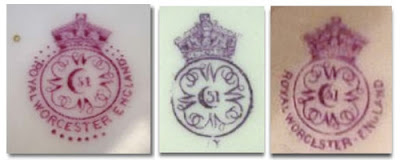 |
| Charles Boyton II silverware for sale at Just Pip It |
Hose_dk from Silver-collector.com
When I talk to Americans they think that the only silver that exists is sterling. Nothing could be more incorrect.
Silver is regulated during hundreds of years according to strict regulation and under heavy punishment – even down to boiling of people who did not apply to the regulations. The use of silver was regulated and controlled. In Denmark silver has been regulated since the 1300dreds and from 1608 a mark with 3 towers has been stamped to all silver objects – no matter how small it was. So please forget all about sterling=silver.
In the old days silver was measured in 16 parts. (Called Lødighed) – 16 lødigt is pure silver. In Denmark good silver was 13½ lod. Representing 13½ part of silver and 2½ part of copper. And please mind marked with 3 towers since 1608 – and at that time – what was USA? (Now I have made myself some enemies here)
Today silver is measured in 1.000 parts. Sterling is 925 parts of 1.000 – French silver has in periods been 950 parts of 1.000 thereby containing more silver than sterling.
German standard is 800, Norwegian is 830, Danish is 830, Swedish the same. So please bear in mind that today we do not buy silver for the contents of silver versus cobber. We buy silver for the beauty and the craftsmanship that the silversmith put in the object rather than some national standard of silver contents.
Silver objects cannot be made out of pure silver (i.e. 1.000). Silver is a soft material and it would be destroyed in use. Therefore we add copper to the silver.
To explain how - imagine that we represent 1.000 silver with a glass of milk. We have some water and the water represent copper. Take 800 ml of milk and mix it with 200 ml of water.
We now have a mixture of milk and water and we cannot separate the two liquids. That is silver partly pure silver added a material copper to make it hard. That is silver.
Silver plated has nothing to do with silver. Silver plated is a base material normally copper, alpaca or nickel silver, or German silver, Brittannia metal or similar. Products that have nothing what so ever to do with silver. Nickel silver and the others look like silver – copper does not. But all these products (base metals) are electroplated (except German and Brittannia silver they look like silver but are not)
Silver plated I will explain by a slice of bread and butter. The slice of bread is the base metal i.e. copper. The butter is silver. You put butter on the bread – and so you do when you make silver plated. In theory you can remove the butter from the slice of bread – the same you can do with silver plated.
As you can understand silver plated is 99% of base metal and a very very very thin layer of silver on top. The layer is so thin that you can polish it off and then you can see the base material through the silver plate. That is what we can see when we have an old spoon etc we can see something red where the silver has been worn off.
Silver plated is a number of things. The old silver plated is made of two very thin silver plates and one copper plate. The two silver plates are placed on both sides of the copper – that is called Sheffield Silver. In this case a fair amount of silver is used. So it is possible to engrave the item – and you can still not see the copper.
Electroplated is not Sheffield Silver. EP is short for Electro Plated. You take a plate of copper and put it into a bath of silver. A very very thin layer of silver is now on top of the copper. Maybe 0,0001mm of silver. Its nothing.
So that was the story of silver and silver plated and electro plated silver – in 10 minutes.
Last summer I went on a cruise with Holland America Line. At our table was also two couples, one from US and one from Canada. In Bergen (Norway) I bought a fully stamped Bergen spoon from 1742. The spoon is more than 250 years old and in perfect condition. And it was very expensive. I had paid a small fortune for the spoon. The spoon represents a “national treasure” - how many spoons do you thing that exists. I theory I had to ask the Norwegian authorities for export permit. But I did not I just took in with me. I would have had the export permit but I did not ask.
At dinner I had brought my 1742 fully stamped Bergen spoon. The American and the Canadian people where very interested until one of the ladies asked “Is it sterling?”
I explained 13½ part silver and 2½ part copper – regulations since 1300dreds etc etc….
The woman replied “Oh its plated” and interest fell below 0
Since then I have made it my task to explain Americans that Sterling is not the only silver!!!!!
Article extracted from: www.silver-collector.com/topic648.html
User: Hose_dk
For silver wares please visit www.justpipit.co.uk
















































